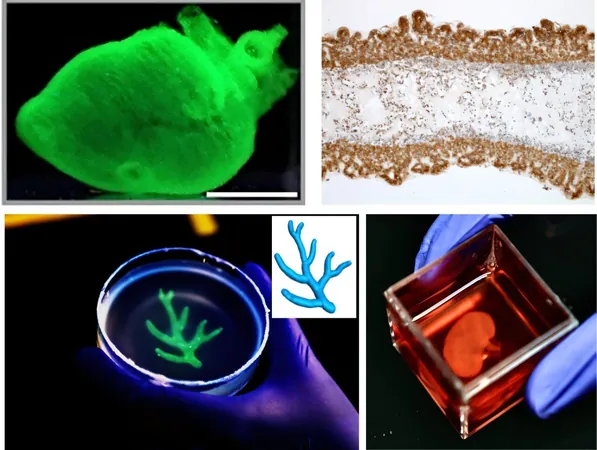
Revolutionary Collagen-Based Bioprinting Method Takes Tissue Engineering to New Heights
2025-06-09
Author: Sarah
In a groundbreaking development, a team of biomedical researchers led by Dr. Michael Mak from Stony Brook University has unveiled an innovative bioprinting method that promises to transform tissue engineering. Dubbed TRACE (Tunable Rapid Assembly of Collagenous Elements), this technique addresses the long-standing challenges of printing natural biomaterials.
TRACE is not just a technical advancement; it's a game-changer in the realms of drug development, disease modeling, and regenerative medicine. Detailed findings were recently published in the prestigious journal, Nature Materials.
Bioprinting operates at the intersection of biology and technology, allowing for the precise placement of biomaterials and living cells to create bioengineered structures. By employing special biological inks (bioinks) along with advanced 3D printing technologies, researchers are able to construct living tissue models essential for medical research. Although bioprinting technologies are still emerging in medicine, they have already found significant applications in industries like automotive manufacturing.
Despite its enormous potential, the bioprinting of functional tissues and organs has faced major hurdles. Traditional bioprinted tissues often fail to replicate the natural behavior of biological cells, rendering them unsuitable for clinical applications. Dr. Mak and his colleagues are optimistic that TRACE will pave the way for breakthroughs in this area.
"Our method is a revolutionary platform technology that facilitates the printing of various tissue and organ types," explains Dr. Mak, who serves as an Associate Professor in the Department of Pharmacological Sciences. "TRACE allows us to manufacture intricate tissue and organ structures using collagen—the body’s natural building block—ensuring high biocompatibility and the seamless integration of living cells."
Collagen, especially Collagen Type I, is the most abundant protein in the human body, serving as a crucial building block for tissues such as skin, muscle, and vital organs including the heart. It not only holds cellular structures together but also plays an essential role in guiding cellular function.
Recognizing these unique properties of collagen, Dr. Mak identifies it as an ideal bioink material.
In their research paper, titled "Instant Assembly of Collagen for Tissue Engineering and Bioprinting," the researchers detail how TRACE expedites the gelation process of collagen, thus enhancing its printability. This is achieved through a technique known as macromolecular crowding, which accelerates the assembly reaction of collagen molecules.
With TRACE, they can fabricate tissues that closely mirror the biological structures found in the body, including functional tissues and small organ-like structures, such as heart chambers.
"TRACE provides a multi-purpose biofabrication platform that makes it possible to 3D print physiological materials and living tissues with both structural complexity and biological function. Our work opens new avenues for precise biofabrication across different organ systems, centered around collagen as a fundamental component," the authors conclude.



 Brasil (PT)
Brasil (PT)
 Canada (EN)
Canada (EN)
 Chile (ES)
Chile (ES)
 Česko (CS)
Česko (CS)
 대한민국 (KO)
대한민국 (KO)
 España (ES)
España (ES)
 France (FR)
France (FR)
 Hong Kong (EN)
Hong Kong (EN)
 Italia (IT)
Italia (IT)
 日本 (JA)
日本 (JA)
 Magyarország (HU)
Magyarország (HU)
 Norge (NO)
Norge (NO)
 Polska (PL)
Polska (PL)
 Schweiz (DE)
Schweiz (DE)
 Singapore (EN)
Singapore (EN)
 Sverige (SV)
Sverige (SV)
 Suomi (FI)
Suomi (FI)
 Türkiye (TR)
Türkiye (TR)
 الإمارات العربية المتحدة (AR)
الإمارات العربية المتحدة (AR)